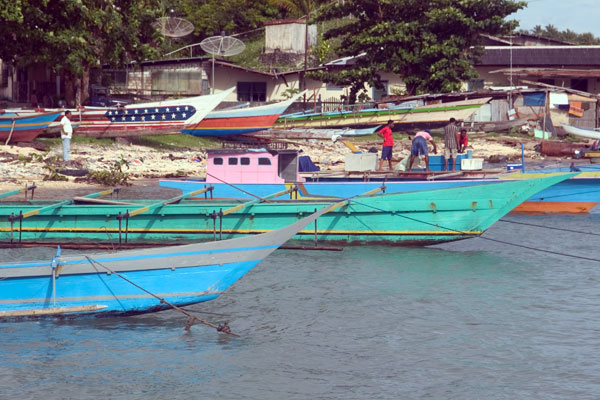- Biak
:"This page is about the island in Papua, Indonesia. For the language spoken there, see
Biak language ".Infobox Islands
name = Biak
image caption = Fishing boats lined up at Kota Biak, Indonesia.
locator
native name =
native name link =
location =South East Asia
coordinates= coord|1|0|0|S|136|0|0|E|type:isle_region:ID
archipelago =
total islands =
major islands =
area =
highest mount =
elevation =
country = Indonesia
country admin divisions title =
country admin divisions =
country largest city =
country largest city population =
population =
population as of =
density =
ethnic groups =Biak is a small
island located inCenderawasih Bay near the northern coast of Papua, anIndonesia n province, and is just northwest ofNew Guinea . Biak is the largest island in its smallarchipelago , and has manyatoll s,reef s, andcoral s.The largest population centre is at
Kota Biak (Biak City) on the south coast. The rest of the island is thinly populated with small villages.Biak is part of the
Biak Islands ("Kepulauan Biak").History
In
World War II , a strategicairfield of theImperial Japanese Army was located there, serving as a base for operations in the Pacific theatre. American forces eventually captured the island during theBattle of Biak . OnMay 29 ,1944 , the firsttank vs. tank battle in the Pacific Theatre occurred. The captured airfield was renamedMokmer Airfield and later transferred to theRoyal Australian Air Force .It was transferred from Dutch rule, along with half of New Guinea, in the 1960s.
Biak Massacre
On
July 1 ,1998 (the anniversary of the unsuccessful 1971 Papuan declaration of independence) Biak was the scene of what is commonly known as the 'Biak Massacre' or 'Bloody Biak'. Native Papuan people and members of the "Organisasi Papua Merdeka" (Free Papua Movement ), raised their traditional flag, 'The Morning Star', at Kota Biak water tower and camped there for the next six days.At 5:30am on
July 6 ,1998 the demonstration was fired upon by the "Tentara Nasional Indonesia" (TNI or Indonesian Military). Many were cut down attempting to flee. Survivors were rounded up and forced to the docks where they were kept for the several days while further demonstrators were caught.About 200 of the original demonstrators were forcibly loaded onto two Indonesian naval vessels and taken to two different locations to be thrown into the ocean. In the following days, bodies washed up on Biak's shores, or were snarled in fishing nets. The TNI explained that the bodies turning up belonged to victims of the
Aitape tsunami which occurred approximately 1000km away inPapua New Guinea .Reference: [http://www.abc.net.au/rn/perspective/stories/2008/2320160.htm]
Demographics
The people of Biak are predominantly
Melanesians and the main religion isChristianity . The official language is Indonesian, with the local dialect being "Biak". Other languages such as Dutch and English are also used, but limited.Tradition
The Biak Numfor culture revolves around their ancient animist religion, although today they are Christian as well.
Their beliefs revolve around a ritual ceremony called Wor, where they will be plagued by all kinds of bad luck and sickness. The Wor is in all aspect of their life and some of their traditional ceremonies are still being held now. They include the first hair cut ceremony (Wor Kapapnik), the growing up ceremony (Wor Famarmar) and the Wedding ceremony (Wor Yakyaker Farbakbuk). All of these ceremonies are accompanied by singing, dancing and offering to ancestral spirits.
Yosim Pancar Dance
The Biak Numfor have a friendship dance called "
Yosim Pancar ". It's small to mid-size dance group formations which could last all-night long. Several "Yosim Pancar" moves that are popular till this day are: Pancar Gas, Gale-Gale, Jef, Pacul Tiga, Seka, andPoco-poco adaptation.The rhythm and song of Yosim Pancar dance are now being modernized with special effect sounds and pop dance beat. Originally the rhythm is to summon ancestal spirits and let them join the group. The traditional musical instrument of this dance is a selfmade stringbass from coconut tree and roots which is similar to the guitar or ukulele.
Flora and fauna
There are numerous types of flora in the island's tropical rain forest. The forest also has a variety trees and other commercially important species plus the lush vegetation of mangrove swamps.
The fauna is very similar to
Australia n fauna such as the group of fowl like pigeon, cockatoo, "nuri" and the reptile group such as snake, turtle and medium sized lizard.References
*
Wikimedia Foundation. 2010.
